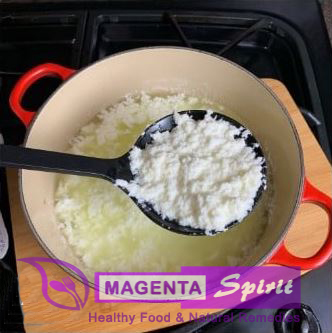Making perfect queso fresco cheese is easier than you think. You don’t need special equipment or hard to obtain ingredients. You need milk, vinegar, and salt. That’s it? Yup, that’s it! Well, you will need cheesecloth, but that’s not really an ingredient. You will also need a good digital thermometer for accurate reading. So, let’s make some queso fresco!
What is queso fresco?
Queso fresco is a one of many popular Mexican cheeses made from whole milk. It is considered a fresh cheese since it is not and aged cheese and is ready to eat right after you make it. It is soft, moist and crumbly so it works great as a topping for tacos, nachos or sprinkling on salads and soups. It is similar to other types of white cheese like farmer’s cheese or paneer from India.
Before I go on, I need to clarify something: queso fresco is curdled with acid, like lemon juice, lime juice or vinegar. Queso fresco will have a slight tangy flavor. Queso blanco, a similar cheese is curdled with rennet, an animal enzyme that you can usually find in the baking aisle of the grocery store. There are also some vegetarian rennet products, but I don’t have any experience with them.
Cheesemaking is another hobby
I’ve tried making ricotta, and goat cheese. The process for making queso fresco is similar, and again, most of the time you will not need special ingredients. Mozzarella cheese and burrata are next on my list. Being Latin American, I really had to try my hand at making queso fresco because you can use it in so many different ways. I like to spread it on baguette and top it with a bit of fig jam. Do you like nachos? Queso fresco is a mild cheese and perfect over tortilla chips to balance a spicy salsa like sour cream does.
The origins of cheese-making go back to approximately the 5th millennium BC, and is attributed to pastoral societies. Terracotta vats with what appear to be draining holes have been found at excavation sites. There is also evidence of cheese-making from drawings found in Egyptians tombs. By the time of the Roman Empire cheese-making was already an established art.
Recipe Card

Queso Fresco Cheese – Recipe
Description
Queso fresco is a one of many popular Mexican cheeses made from whole milk. It is considered a fresh cheese since it is not and aged cheese and is ready to eat right after you make it.
Ingredients
Instructions
-
Place a cheese cloth lined colander.
Place a cheese cloth lined colander over a large bowl of pasta pot.

-
On medium heat bring milk.
On medium heat bring milk to 170°F, stirring constantly to avoid uneven heating.

-
Remove from heat and add vinegar types.
When the milk reaches the desired temperature, remove from heat and add vinegar types. Stir a couple of times, then allow it to sit untouched on the stove top for about 30-45 minutes.

-
Start breaking up the curds.
Using a knife start breaking up the curds gently then start transferring to a colander using a slotted spoon.

-
Allow the curds to sit untouched.
Allow the curds to sit untouched for about 30 minutes so they can drain properly. Add salt and stir lightly.

-
Gather the edges of the cheesecloth and tie.
Next, gather the edges of the cheesecloth and tie with kitchen twine or a twist tie. Hang from your sink faucet, and allow it to drip for about 30 minutes.

-
Remove from the cloth.
Remove from the cloth and using your hands gently mold the cheese into a flat disc, about 1″ tall.
-
Return to the colander.
Return to the colander and let it sit this way for about 30 minutes.
-
Transfer cheese to a bowl.
Transfer cheese to a bowl, and place in the refrigerator until ready to use.
Servings 8
- Amount Per Serving
- Calories 148kcal
- % Daily Value *
- Total Fat 7g11%
- Saturated Fat 4.01g21%
- Cholesterol 23mg8%
- Sodium 538mg23%
- Potassium 312mg9%
- Total Carbohydrate 11g4%
- Sugars 11g
- Protein 7g15%
- Vitamin A 385 IU
- Calcium 269 mg
- Iron 0.1 mg
* Percent Daily Values are based on a 2,000 calorie diet. Your daily value may be higher or lower depending on your calorie needs.
Note
This recipe calls for white distilled vinegar and apple cider vinegar. This is the key ingredient for acid-set cheese or acid coagulated cheeses. Other types of acid-set cheese are cottage cheese, quark or cream cheese.
NOTE: This content may be subject to copyright. Copying content or any part of this website is prohibited. Printing content of this website for reading and personal use is allowed. More information on this can be found in the Terms and Conditions section. © 2024, magentaspirit.com. All Rights Reserved!













